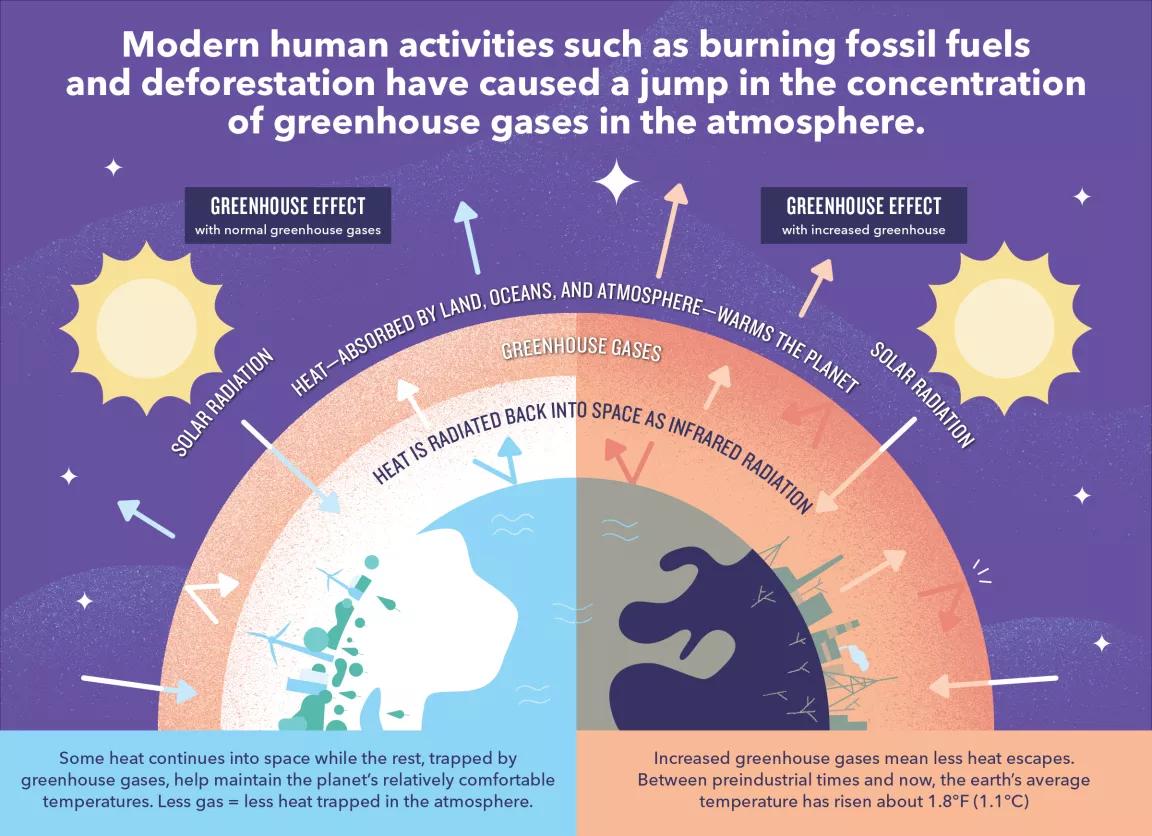Ahmedabad
(Head Office)Address : 506, 3rd EYE THREE (III), Opp. Induben Khakhrawala, Girish Cold Drink Cross Road, CG Road, Navrangpura, Ahmedabad, 380009.
Mobile : 8469231587 / 9586028957
Telephone : 079-40098991
E-mail: dics.upsc@gmail.com

GHG emissions concentration hit record high
News: Recently, the United Nations issued a warning highlighting the unprecedented surge in greenhouse gas concentrations in the atmosphere, setting new records in 2022.
Key Highlights:
The key highlights of the UN’s World Meteorological Organization (WMO)'s 19th Annual Greenhouse Gas
Bulletin are as follows:
• Record High Levels: Atmospheric levels of the three main greenhouse gases – carbon dioxide, methane, and nitrous oxide reached new record highs in 2022.
• Increase in CO2 Concentrations: Global averaged concentrations of carbon dioxide (CO2), the most important greenhouse gas, in 2022 were a full 50% above the pre-industrial era for the first time. They continued to grow in 2023.
• Methane and Nitrous Oxide: Methane concentrations also grew, and levels of nitrous oxide, the third main gas, saw the highest year-on-year increase on record from 2021 to 2022.
• Radiative Forcing: From 1990 to 2020, radiative forcing – the warming effect on our climate - by long-lived greenhouse gases increased by 47%, with CO2 accounting for about 80% of this increase.
• Global Greenhouse Gas Watch: The WMO Greenhouse Gas Bulletin devotes its cover story to the Global Greenhouse Gas Watch, which was approved by the World Meteorological Congress in May. This ambitious initiative envisages sustained greenhouse gas monitoring in order to be able to account for both human activities related and natural sources and sinks.
Factors responsible for rising GHG concentration:
• The predominant contributor to carbon dioxide (CO2) emissions is the burning of fossil fuels for energy.
• Forests act as carbon sinks, absorbing CO2. Deforestation and land-use changes, primarily for agriculture or urbanization, reduce these sinks, releasing stored carbon and reducing the Earth's capacity to absorb CO2.
• Improper waste management, especially in landfills, contributes to the generation of methane as organic waste decomposes in anaerobic conditions.
• Permafrost Thaw and Methane Release: As permafrost thaws due to rising temperatures, it releases methane, a potent greenhouse gas trapped within the frozen soil.
• Agriculture contributes significantly to methane (CH4) and nitrous oxide (N2O) emissions.
Consequences of Rising concentration of GHG:
• Global Warming: Increasing greenhouse gas concentrations tend to warm the planet. In computer-based models, rising concentrations of greenhouse gases produce an increase in the average surface temperature of the earth over time.
• Climate Change: Rising temperatures may produce changes in precipitation patterns, storm severity, and sea level. Collectively, this is commonly referred to as climate change.
• Ocean Acidification: Increased CO2 in the atmosphere can be absorbed by oceans, increasing their acidity and turning it into carbonic acid. This acid uses up the carbonate in the water so it’s not available for sea creatures who need it for skeleton and shell building and coral reefs.
• Ecosystem Disruption: Changes in climate can disrupt ecosystems, leading to shifts in wildlife populations and the timing of natural events like flowering and migration.
• Human Impact: Climate change can have serious human impacts, including increased risk of extreme weather events (such as hurricanes, floods, and droughts), threats to public health, and economic consequences (such as damage to infrastructure and agriculture)
• Food and Water Security: Changes in temperature and precipitation patterns can affect agricultural productivity, leading to crop failures and reduced food security. Water scarcity or excessive rainfall can impact water availability for drinking, agriculture, and industry.

Address : 506, 3rd EYE THREE (III), Opp. Induben Khakhrawala, Girish Cold Drink Cross Road, CG Road, Navrangpura, Ahmedabad, 380009.
Mobile : 8469231587 / 9586028957
Telephone : 079-40098991
E-mail: dics.upsc@gmail.com
Address: A-306, The Landmark, Urjanagar-1, Opp. Spicy Street, Kudasan – Por Road, Kudasan, Gandhinagar – 382421
Mobile : 9723832444 / 9723932444
E-mail: dics.gnagar@gmail.com
Address: 2nd Floor, 9 Shivali Society, L&T Circle, opp. Ratri Bazar, Karelibaugh, Vadodara, 390018
Mobile : 9725692037 / 9725692054
E-mail: dics.vadodara@gmail.com
Address: 403, Raj Victoria, Opp. Pal Walkway, Near Galaxy Circle, Pal, Surat-394510
Mobile : 8401031583 / 8401031587
E-mail: dics.surat@gmail.com
Address: 303,305 K 158 Complex Above Magson, Sindhubhavan Road Ahmedabad-380059
Mobile : 9974751177 / 8469231587
E-mail: dicssbr@gmail.com
Address: 57/17, 2nd Floor, Old Rajinder Nagar Market, Bada Bazaar Marg, Delhi-60
Mobile : 9104830862 / 9104830865
E-mail: dics.newdelhi@gmail.com